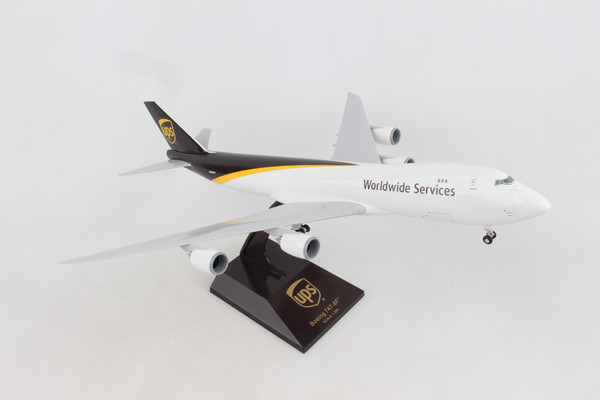Product Overview
Comprising superior quality, solid, substantial injection molded plastic components with a simple snap-fit design that allows for easy assembly without the need for glue, this SkyMarks 1/200 scale UPS Boeing 747-8F - with Registration N606UP - measures approximately 15-1/16-inches long with a 13-5/8-inch wingspan and comes complete with Landing Gear and a Display Stand. An accurate, true-to-scale reproduction of the actual aircraft, the model is great for collectors and features authentic, highly detailed graphics and markings. Easily discernible from earlier 747 models by its prominently curved aerodynamic wings with raked back wingtips and chevrons on its engine nacelles, the Boeing 747-8 was initially introduced in 2005 as a larger, quieter and more advanced and fuel-efficient variant of its predecessor, the Boeing 747-400, and utilizes the same cockpit and engine technology as its sibling, the Boeing 787, which is acknowledged by the suffix, 8 after 747 (747-8F), with the "F" designating it as a "Freighter." Unlike the passenger version of the Boeing 747-8i, which can carry more than 400 passengers in a 3-class configuration, the Boeing 747-8F freighter variant not only has a noticeably shorter upper deck, it is manufactured with a hinged opening nose door along with a side door on the main deck and a side door on the lower deck to facilitate loading and unloading the aircraft. The Boeing 747-8F also boasts a greater payload capacity than its predecessor, the Boeing 747-400ERF, the aircraft from which it was derived. The first 787-8F (Freighter) was delivered to launch customer, Cargolux in late 2011. Interestingly, the large, quad-engine Boeing 747 was initially conceived in the mid-1960s, when supersonic transports were also concurrently on the drawing board, and viewed more favorably at the time as the likely successor for the future travel, Boeing engineers and Pan Am CEO, Juan Trippe opted for the Boeing 747 to be designed so that it could be readily converted into a freighter by merely retrofitting the fixed nose of the existing passenger aircraft with a large hinged cargo door. Consequently, if a passenger 747 aircraft were ever to be adapted as a cargo version with a hinged cargo door, it would be much more cost effective and considerably easier to convert existing passenger aircraft into cargo aircraft if the cockpit were located above the nose, thus enabling existing passenger 747s to continue flying as transformed cargo planes. Even though supersonic transports did not readily materialize for the most part, and did not supersede the Boeing 747 as initially envisioned, over time, the Boeing 747 was not only embraced as a successful passenger and cargo aircraft, many passenger Boeing 747 aircraft were ultimately converted into cargo 747 aircraft, known as BCF - Boeing Converted Freighter(s) when it was no longer viable that they continue to be used as passenger aircraft.









